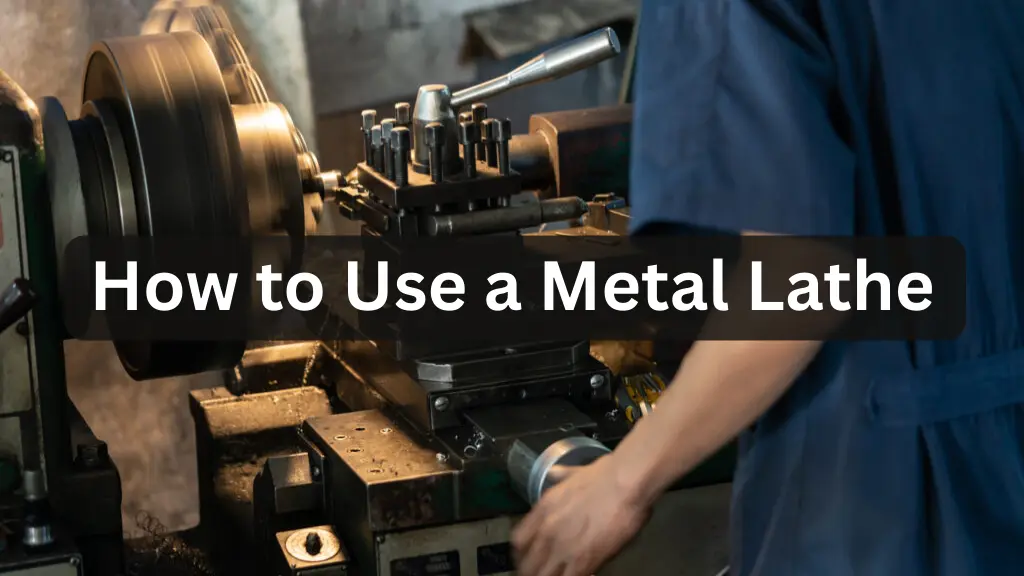Learning how to use a metal lathe is one of the most valuable skills for anyone interested in machining, metalworking, or DIY projects that require precision. Metal lathes are versatile machines that shape, cut, drill, and polish metal into exact dimensions. Whether you are a beginner experimenting with small parts or a professional machinist producing components for industries like automotive and aerospace, mastering the metal lathe opens the door to endless possibilities.
This guide will cover everything you need to know, from understanding the essential parts of a lathe to step-by-step instructions, safety practices, troubleshooting, and real-world examples. By the end, you will have a clear understanding of how to use a metal lathe efficiently and confidently.
What Is a Metal Lathe
A metal lathe is a machine tool used to remove material from a workpiece while it is rotated against a cutting tool. Unlike wood lathes, which are designed for softer materials, metal lathes are built to handle harder substances such as steel, brass, aluminum, and titanium. The machine ensures accuracy, allowing machinists to create precise parts with exact dimensions.
Common Uses of a Metal Lathe
- Turning cylindrical shafts and rods
- Cutting threads on bolts or pipes
- Boring holes to precise sizes
- Facing surfaces to make them flat
- Creating tapers and contours
- Polishing or sanding metal surfaces
Types of Metal Lathes
- Mini Lathes: Compact machines suitable for beginners and hobbyists working on small parts.
- Bench Lathes: Medium-sized, mounted on a bench, commonly used in schools and workshops.
- Industrial Lathes: Large and powerful, used in manufacturing facilities for heavy-duty machining.
Essential Parts of a Metal Lathe
To operate a metal lathe effectively, it is important to understand its main components and their functions. Each part works together to ensure accuracy, stability, and precision during machining. Knowing these essentials not only helps with operation but also with proper maintenance and troubleshooting.
-
Headstock
The headstock is located at one end of the lathe and contains the motor and spindle. The spindle rotates the workpiece and is often supported by bearings for smooth operation. Depending on the machine, the headstock may also include gears or speed controls to regulate spindle speed. This makes it a critical part for controlling overall performance.
-
Tailstock
Positioned opposite the headstock, the tailstock provides support for the other end of the workpiece. It can hold tools such as drill bits, reamers, or centers, making it essential for drilling and boring operations. The tailstock can be moved along the bed and locked into place as needed. This ensures both flexibility and accuracy in machining.
-
Carriage
The carriage travels along the bed and holds the cutting tool securely during operations. It includes several parts such as the cross slide, compound rest, and tool post, each contributing to precise tool movement. By adjusting these controls, the operator can guide the cutting tool at different angles and depths. This precision makes the carriage one of the most important parts of the lathe.
-
Bed and Ways
The bed forms the foundation of the lathe, providing stability and alignment for all other components. Attached to the bed are the ways, which are precision-machined rails that guide the carriage and tailstock. These ensure smooth sliding motion and consistent alignment during work. A solid bed and accurate ways are vital for achieving high-quality machining results.
-
Tool Post and Cutting Tools
The tool post is designed to hold and secure the cutting tools during operation. It can be adjusted to fit different types of cutters, depending on the machining task. Cutting tools themselves vary widely, from single-point cutters to specialized inserts for threading or shaping. Together, the tool post and cutters determine the precision and quality of the finished workpiece.
Safety Guidelines Before Using a Metal Lathe
Safety is the most important aspect of learning how to use a metal lathe. These machines are powerful and precise, but improper handling can result in serious accidents. By following essential precautions and maintaining awareness, you can ensure both productivity and safety in your workshop.
-
Protective Gear
Always wear the proper protective gear before operating a lathe. Safety glasses or a face shield protect your eyes from flying chips and sharp fragments. Gloves can be useful when handling raw materials, but they should never be worn during operation to avoid entanglement. Close-fitting clothing and tied-back hair are also essential, as loose items can easily be caught by rotating parts. Ear protection is recommended in noisy environments to reduce long-term hearing damage.
-
Pre-Operation Checks
Before switching on the machine, carry out a series of checks to confirm it is ready for safe use. Ensure that the workpiece is clamped securely in the chuck or between centers. Inspect the cutting tools to verify they are sharp, correctly mounted, and properly aligned. Check that the machine is well-lubricated to avoid unnecessary friction. Finally, clear away any loose objects or tools near the lathe to prevent hazards during operation.
-
Common Mistakes to Avoid
There are a few critical mistakes that every operator should avoid when using a lathe. Never leave the chuck key in the chuck, as it can be thrown at high speed when the machine starts. Do not set cutting speeds higher than what is recommended for your material, as this can cause tool damage or unsafe conditions. Avoid leaning too close to the rotating spindle to reduce the risk of contact. Finally, do not force the tool into the workpiece; let the machine perform the cutting at its own pace.
Step-by-Step Guide on How to Use a Metal Lathe
Learning how to use a metal lathe requires patience, attention to detail, and practice. By following a structured process, beginners and experienced machinists alike can achieve accurate and professional results. Below is a step-by-step guide that covers the fundamentals of lathe operation.
Step 1: Setting Up the Workpiece
Begin by mounting the workpiece securely in the chuck or between centers. A solid grip is essential for safe and accurate machining. Use a dial indicator to check alignment and ensure the workpiece runs true without wobbling. Proper setup at this stage prevents errors and guarantees smoother operations later.
Step 2: Choosing and Installing the Right Tool
Select the correct cutting tool for the operation you want to perform. Facing tools flatten the ends of the workpiece, turning tools reduce diameter, and threading tools create screw threads. Install the tool firmly in the tool post and adjust it so the tip aligns with the centerline of the workpiece. Correct tool height improves cutting efficiency and precision.
Step 3: Adjusting Speeds and Feeds
Set spindle speed based on the type of material being machined. Softer metals like aluminum can be cut at higher speeds, while harder materials such as steel require slower speeds to avoid tool damage. Adjust the feed rate to control how fast the tool moves into the workpiece. Finding the right balance ensures clean cuts and extends tool life.
Step 4: Performing Basic Operations
- Facing: Cut across the end of the workpiece to make it flat.
- Turning: Reduce the diameter by moving the tool parallel to the axis.
- Drilling: Mount a drill bit in the tailstock and bore holes into the workpiece.
- Boring: Enlarge existing holes with a boring tool.
- Threading: Cut screw threads by using the threading dial and the lead screw.
Step 5: Measuring and Checking Accuracy
After each step, measure the workpiece to confirm accuracy. Tools such as calipers, micrometers, and dial indicators are commonly used for precise measurements. Checking dimensions regularly ensures the project stays within tolerances. Since accuracy is the goal of lathe operations, measurement is as important as the cutting process itself.
Beginner-Friendly Projects for Metal Lathes
Starting with simple projects is the best way for beginners to gain hands-on experience with a metal lathe. These tasks focus on basic operations, measurement skills, and machine handling. By completing smaller projects first, new machinists build confidence and develop precision before moving on to more advanced work.
1. Making Bushings and Spacers
Bushings and spacers are straightforward parts that help learners understand accurate turning and sizing. They involve cutting a cylindrical piece to a specific outer and inner diameter. Beginners practice boring, facing, and measuring tolerances while producing parts that can be used in real applications. These projects build a solid foundation for future precision work.
2. Turning Small Shafts or Rods
Creating small shafts or rods is another beginner-friendly task that introduces parallel turning. These pieces are often used in model engines or mechanical assemblies. The project teaches how to maintain consistent diameters along a length of material. Beginners also learn how to select the right speed and feed rates for clean results.
3. Creating Basic Screw Threads
Thread cutting is a valuable skill for any machinist. By using a threading tool and the lead screw, beginners can cut simple external threads on a rod. This exercise improves tool alignment skills and teaches coordination with the threading dial. Completing this project helps new users gain confidence in producing functional, threaded parts.
4. Making Simple Tools
A great project for newcomers is making simple tools such as punches, small hammers, or handles. These projects combine facing, turning, and knurling operations. Not only do they teach core machining skills, but they also result in practical tools that can be used in future projects. This makes learning more rewarding and productive.
5. Skills Gained Through Practice
Each beginner project reinforces critical skills like tool setup, proper speed selection, and accurate measuring. Working on small parts helps new machinists understand tolerances and the importance of precision. Over time, these exercises build the knowledge and confidence needed to tackle more complex machining tasks.
Advanced Techniques for Professionals
Once the basics are mastered, machinists can begin exploring advanced operations. These methods require greater precision, attention to detail, and in some cases, specialized equipment. They are typically applied in industries like aerospace, automotive, and precision engineering.
-
CNC Integration
Modern metal lathes can be upgraded with CNC controls, allowing automated machining. This enhances accuracy, repeatability, and efficiency, especially for large production runs. CNC programming helps create intricate parts that would be difficult to machine manually.
-
Precision Threading
Professional machinists often work on fine threading projects for industries requiring high tolerances. Aerospace and automotive sectors rely heavily on precise threads. Specialized threading tools and careful use of the threading dial ensure accuracy and consistency.
-
Taper Turning
This technique involves cutting angles or conical shapes along the workpiece. By adjusting the compound rest, machinists can produce smooth tapers for various components. Taper turning is essential for creating machine tool parts and custom fittings.
-
Boring Complex Shapes
Advanced boring operations allow the creation of intricate internal profiles. Professionals use boring bars and specialized tooling to achieve precision. This technique is vital for producing engine components and other specialized mechanical parts.
Maintenance Tips for Your Metal Lathe
A well-maintained lathe lasts longer and produces better results.
- Clean chips and debris after every use.
- Regularly lubricate moving parts such as the lead screw and carriage.
- Check alignment between the headstock and tailstock.
- Inspect belts, gears, and bearings for wear.
- Store cutting tools in a dry place to prevent rust.
Real-World Applications of Metal Lathes
Metal lathes play a critical role in multiple industries.
- Automotive: Manufacturing engine parts, shafts, and brake components.
- Aerospace: Producing high-precision parts for aircraft and spacecraft.
- Jewelry: Crafting rings, bracelets, and artistic pieces with high detail.
- Education: Teaching machining fundamentals in trade schools and universities.
Common Problems and Troubleshooting
Even experienced machinists encounter issues. Knowing how to fix them saves time and improves results.
- Tool Chatter: Caused by loose setups or incorrect speeds. Tighten fixtures and adjust speed.
- Poor Surface Finish: Often due to dull tools or excessive feed rates. Use sharp tools and adjust feeds.
- Misalignment: Check headstock and tailstock alignment if parts are uneven.
- Overheating: Use cutting fluids to cool tools and extend tool life.
Expert Insights on Using Metal Lathes
Experienced machinists often emphasize that patience and precision are more important than speed. A real-world example comes from a workshop technician who explained how slowing down spindle speed extended the life of carbide tools and produced cleaner finishes. Another machinist noted that regular calibration checks reduced scrap material and saved costs.
Conclusion
Knowing how to use a metal lathe is a skill that blends art with engineering. By understanding the machine’s components, following safety protocols, and practicing both basic and advanced techniques, anyone can achieve precision results. Whether you are creating small DIY parts, producing industrial components, or exploring machining as a career, the metal lathe will remain one of the most valuable tools in your workshop.
Start with beginner projects, maintain your equipment, and keep learning from experienced machinists. With patience and practice, you will master the craft of metalworking and discover the countless possibilities that come with it.
FAQs
Can a beginner use a metal lathe
Yes, beginners can learn to use a metal lathe by starting with small projects. Many entry-level lathes are designed for home workshops and hobbyists.
What is the difference between a metal lathe and a wood lathe
Metal lathes are built with stronger materials, higher precision, and slower spindle speeds to handle hard metals, while wood lathes are lighter and operate at higher speeds.
How much does a good metal lathe cost
A mini lathe can start around a few hundred dollars, while professional-grade industrial lathes can cost tens of thousands depending on size and features.
Do I need special training to operate a lathe
Formal training is helpful but not always required. Many machinists learn through apprenticeships, online tutorials, or guided practice. Safety knowledge is essential before operating.
What is the best metal lathe for beginners
Bench lathes or mini lathes are excellent for beginners because they are smaller, easier to manage, and more affordable.




